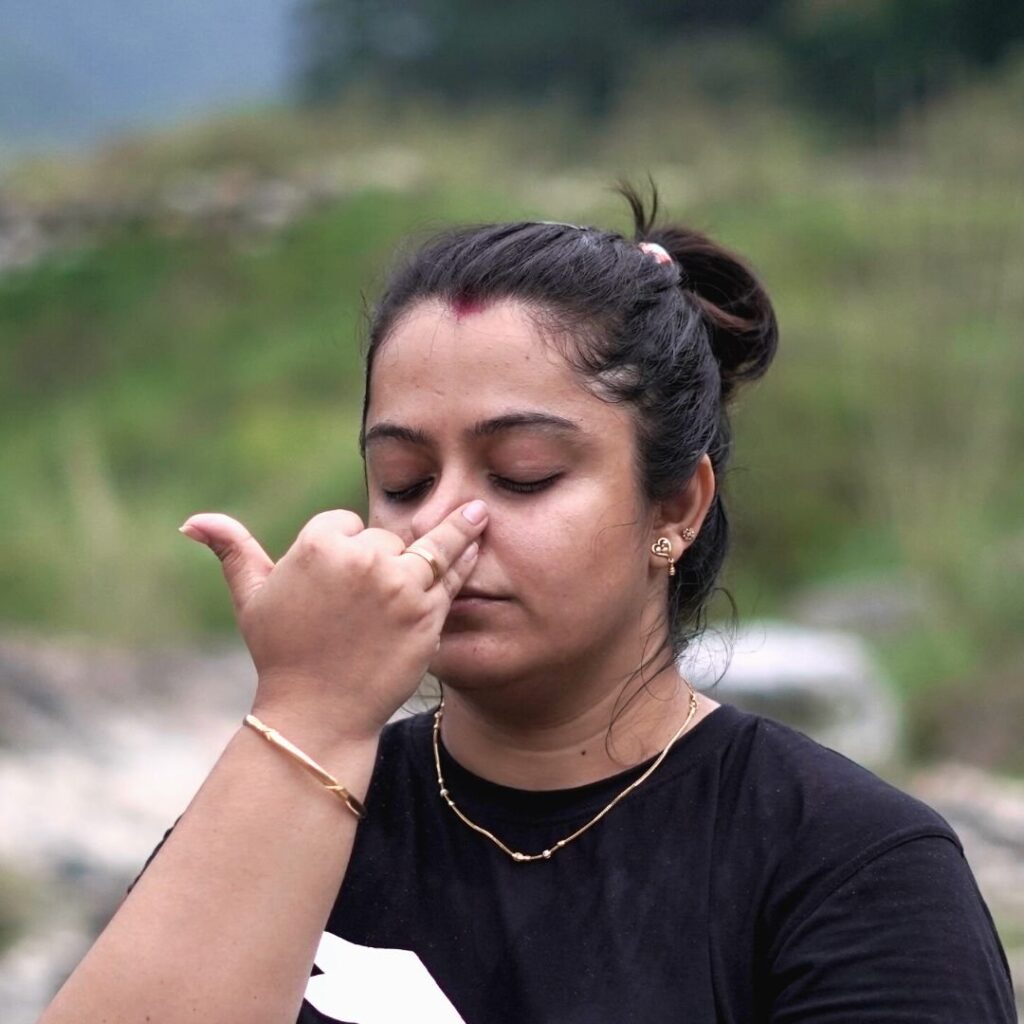Nadi Shodhana Pranayama (Channels Purification)
Also called, Alternate Nostril breathing, this is one of the Pranayamas, you can do as a beginner. It is one of the most widely practiced Pranayamas, till date. Nadi is basically a Sanskrit word, that means ‘channel’ and Shodhana means ‘purification’. Thus, you can come to the point, that Nadi Shodhana is a Pranayama that aims to clear and purify the channels of the body, that are not visible to the eyes.
Anatomical Implications
Nadi shodhana pranayama has profound effect on the respiratory system, i.e., it decreases the work of breathing, strengthens, and also trains the diaphragm and other respiratory and abdominal muscles.
Read More: Why Is Kundalini Yoga Dangerous? The Truth About Its Risks and Rewards
Moreover, it also improves gas exchange and oxygenation, provides good breath control, and helps in coughing impurities. Other effects include reducing stress, giving more relaxation, multiplication of energy and vitality and improvement in overall health and well-being.
Practicing Nadi shodhana Pranayama enhances voluntary regulation of the breathing to make respiration rhythmic and to calm the mind. The practice of Nadi shodhana is the art of controlling the breath. During the practice you have to keep your attention on the act of breathing, leading to concentration which in turn will de- stress and improve the pulmonary functions.
How to Do Nadi Shodhana Pranayama ?
You can practice this Pranayama is a proper way, if you follow the guidelines.
- You can sit in a comfortable position, with your legs crossed. Make the Mrigi mudra/Visnu Mudra, with your hands. In the beginning, new practitioners can have problem, keeping the hand floating for a length of time. You can keep a cushion or a bolster on your lap, initially.
- You have to close the right nostril, with your thumb. Inhale the air through the left one, and then close it with your ring finger and little finger. Open and exhale the residual air through the right one.
- Then, you have to keep the right nostril open, and inhale the fresh air and then close it again. Exhale slowly through the left. This is one complete cycle. You have to repeat the cycles 3-5 times. After you are done, you have to release the hand mudra, and start normal breathing.
- In Nadi Shodhana Pranayama, you have to practice retention of breath. It is also called as fixed ratio breathing. You can chant seed mantras, in your mind, while practicing this Pranayama. For beginners, it is best to concentrate on the inhalation and exhalation.

Precautions
- You have to keep the ratio of inhalation, retention and exhalation in the ratio of 4:4:8. Once you are able to do it, without any issues, you can increase the ratio.
- You should perform the Pranayama on an empty stomach.
- Always do it under yoga experts.
Benefits of Nadi Shodhana Pranayama
- If you practice Nadi Shodhana on a regular basis, you will start experiencing a lower heart rate, and reduced stress and anxiety.
- It is also said to balance the two parts of the brain.
- If you practice it on a regular basis, slowly you will experience purification of the energy channels. The prana or the life force will be able to flow in a proper manner, too.
- It also regulates the nervous system.
- You can breathe better, if you do this Pranayama on a regular basis.
- You will also experience lower anxiety and fear.
Contraindication Nadi Shodhana Pranayama
Most people can practice Nadi Shodhana without any side effects. Although, something as gentle as this breathing technique has huge positive benefits, if you should take things lightly, if you are suffering from COPD. Moreover, if you use inhalers and nebulisers, you can keep them near you. Do not force your breath, just take things slowly as they come. If you have symptoms, like chest pain, shortness of breath, or vomiting tendency, then you should not do this practice.

Variation Of Nadi Shodhana Pranayama
The advanced version of Nadi Shodhana occurs for the same inhalation timing, but extends the exhalation to around eight counts. When you master this, you may wish to add retentions in between. Between the inhalation and the exhalation, pinch both sides of the nose close, and retain the breath for four counts. This is Antar Kumbhaka: retention with lungs full. After some time, you may add Bahir Kumbhaka at the end of the exhalation, also for four counts. This is retention with lungs empty.
More advanced, extended Nadi Shodhana practices can be done after a few months of practice. You can continue with advanced variations, if your body is able to cope with the practice.
Read More: Everything You Need to Know About Kundalini Yoga Teacher Training
Conclusion
If you practice Nadi Shodhana, even for 5 minutes a day, it will have immense benefits on your body. If you can increase the timing to 10-15 minutes, it will be even better. When you complete the session, it is best to exhale through the left nostril and conclude. You should observe the effects of the practice for some time, to unearth its benefits.
Deepen Your Yoga Practice with Hari Om Yoga Vidya School
Located in the heart of Rishikesh, Hari Om Yoga Vidya School is a place where ancient yogic wisdom meets modern teaching techniques. As a top yoga school in Rishikesh, we are committed to providing authentic, immersive yoga education in a peaceful, spiritual setting. Recognized as one of the best yoga schools in Rishikesh, we offer structured training programs designed to help you evolve in your practice, whether you are a beginner or an experienced yogi.
If you’re searching for a yoga school in Rishikesh that focuses on holistic learning, experienced teachers, and a supportive community, look no further!
Explore Our Yoga Teacher Training & Retreats
At Hari Om Yoga Vidya School, we offer a range of courses tailored for different levels of practitioners:
✅ 100-Hour Yoga Teacher Training in Rishikesh – A foundational course for those looking to begin their yoga journey.
✅ 200-Hour Yoga Teacher Training in Rishikesh – An internationally recognized certification for aspiring yoga teachers.
✅ 300-Hour Yoga Teacher Training in Rishikesh – Advanced training to deepen your practice and refine your teaching skills.
✅ 7-Day Yoga Retreat in Rishikesh – A rejuvenating escape into yoga, meditation, and self-discovery.
✅ 10-Day Yoga Retreats in Rishikesh – A transformative experience that blends yoga, relaxation, and Himalayan serenity.
Join us for a life-changing experience and become part of our global yoga family! 🌿✨



